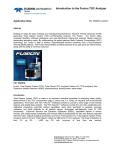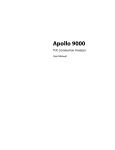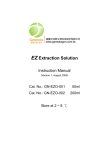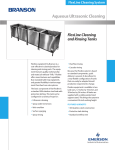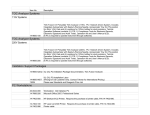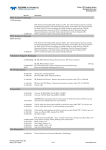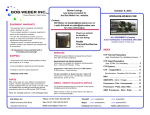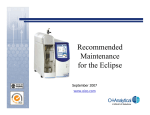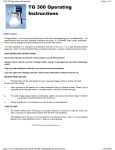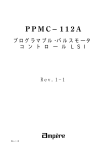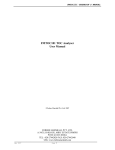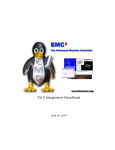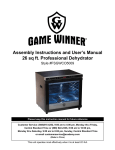Download Apollo 9000 TOC/TN Applications Development
Transcript
4736 Socialville Foster Road Mason, Ohio 45040 T: (513) 2297000 (800) 5434461 F: (513) 2297050 www.teledynetekmar.com Apollo 9000 TOC/TN Applications Development and Troubleshooting Guide Goal This guide is intended to help TOC analysts optimize the Apollo 9000 for their sample analysis by addressing major application concerns and providing helpful troubleshooting tips. Section One Acid Preservation Sulfuric acid, hydrochloric acid, phosphoric acid and nitric acid are common acids used for sample preservation. The following sections outline acidification considerations for the Apollo 9000 TOC and TOC/TN instruments. Phosphoric Acid Recommended by Teledyne Tekmar for use with the Apollo 9000 TOC and TOC/TN analyzers. Hydrochloric Acid HCl, in combustion TOC instruments, will form HCl gas. Since most commercial analyzers use an NDIR to detect CO2 and they have a gold lined sample cell, the corrosive nature of HCl is a problem. Some of the HCl can be scrubbed from the gas stream using copper and tin but some may break through and cause the detector to be corroded. Samples that contain hydrochloric acid (HCl) will form HCl gas in combustion TOC instruments. Since most commercial analyzers that are equipped with a goldlined sample cell use an NDIR to detect CO2, the corrosive nature of HCl can damage the NDIR. The Apollo 9000 copper and tin scrubber manages to scrub out some HCl, but HCl breakthrough is common and causes NDIR detector corrosion. Sulfuric Acid Sulfuric acid, H2SO4, in combustion TOC instruments, will form SO3 gas. It has been observed that the SO3 can be absorbed to some extent by the catalyst in the combustion tube. After some amount has been absorbed the catalyst becomes saturated and then, with each ensuing injection of water, some of the SO3 is released and will cause a response in the NDIR detector. It also affects the corrosives scrubber used to protect the detector, causing additional maintenance. An additional scrubbing device can be used ahead of the corrosives scrubber that will remove the SO3 from the gas going to the detector without removing CO2. Teledyne Tekmar recommends installing the SO3 Mist Scrubber when running samples that contain sulfuric acid. Please contact Teledyne Tekmar Customer Support for additional information or to order the SO3 Mist Scrubber. Nitric Acid Nitric Acid is not recommended due to the damaging effects of this acid on the multistage autosampler needles used with the Apollo 9000 TOC and TOC/TN analyzers. Page 1 of 5 Over Acidification TOC methodologies vary in their requirements for the preservation of samples. Since many present day TOC analyzers will automatically add an aliquot of acid to samples before sparging to remove inorganic carbon (IC), problems can arise from adding acid to the already acidified samples collected in the field. In the case of preacidified samples, additional acid should not be used. Optimizing the Automated Acid Addition The Apollo 9000 TOC and TOC/TN systems are designed to handle difficult matrices, some of which are highly basic in nature. Before running your samples on the Apollo TOC analyzer, please verify that the amount of acid added and the ASM sparge time in the method is appropriate for your samples. Verifying the ASM Acid Volume – For highly basic samples, the standard 0.3 ml of acid addition for TOC analysis may not be enough to remove the IC from your samples. The acid added can be verified by adding the equivalent amount of acid to your samples outside of the instrument and confirming that the pH is 2 or less. If additional acid is needed, please make a new method with the appropriate amount of acid. Verifying the ASM Sparge Time – For samples that contain a very high amount of IC, the standard 240 seconds of ASM sparge time may not be enough to fully sparge the sample. For these situations you will need to experiment with increased IC sparge times to determine the appropriate time for your application. If additional ASM sparge time is needed, please make a new method with the appropriate ASM sparge time. Section Two – Sea Water and Brine Samples Analysis of samples containing high concentrations of salt offer a difficult challenge for high temperature combustion analyzers. Metal cations such as sodium have the effect of devitrifying the quartz combustion tube (causing it to crystallize and break). Salts can also deposit on the catalyst resulting in a loss of efficiency. To improve the ability of the Apollo 9000 for performing TOC analysis of salty waters, the following strategies can be used: Decrease Injection volume. Depending on the level of carbon in the sample, it is best to use as little of the sample as possible to prolong the life of the catalyst. Dilute the sample. This can be done manually or automatically for TOC and TC analyses. Samples can be diluted by using the TOC_TC Method 1,00025,000 (Method 1005,000 for Apollo 9000 HS). Refer to Section 6.3 of the Apollo User’s Manual on making new methods. Following the directions on Section 6.3, the following parameters should be modified: Injection volume: aliquot of diluted sample injected in the combustion tube Sparger volume: Amount of sample transferred into the Sparger for dilution. Dilution Volume: amount of DI water added to the IC sparger to dilute the sample. Example: A sample containing 1% salt and 20 ppmC can be automatically diluted by a factor of 10. So the method setup should be changed to: Injection volume: 0.1 mL Sparger volume: 0.5 mL Dilution volume: 4.5 mL Page 2 of 5 A total amount of 5 mL for the sparger and dilution volume is recommended to make sure that there is enough liquid for efficient mixing and enough sample for the analysis. If the sample foams a lot, a higher dilution should be used. Combustion Tube and Catalyst Maintenance Accumulated salt will accelerate the need for catalyst and combustion tube maintenance. Refer to Section 7.3.3 and 7.3.4 of the Apollo 9000 User’s Manual for maintaining the catalyst and combustion tube. Based on your sample load, set up a schedule for catalyst and combustion tube cleaning and eventual replacement. For general guidelines on schedule timing refer to published application notes (available on the Teledyne Tekmar website, www.teledynetekmar.com) or consult the Teledyne Tekmar Customer Support Center. To minimize downtime, prepare a second combustion tube assembly. Section Four – Samples with High Acid Content Samples containing 50% or more acid present a challenge for a combustion instrument. The introduction of large amounts of acid results in decrease in efficiency of the combustion catalyst. If it is necessary to run these types of samples, the following measures must be taken: 1. Decrease Injection volume. Depending on the level of carbon in the sample, it is best to use as little of the sample as possible to prolong the life of the catalyst. 2. Do not add more acid to the sample. Make a new method by following the instructions on Section 6.3. Under acid volume, type 0 mL. 3. Dilute the sample. This can be done manually or automatically for TOC and TC analyses. See the discussion on Section 7.4. 4. Attach a scrubber to the system if necessary. Refer to Section 6.1 for discussion on effects of different acids on the analyzer. 5. Introduce the sample through the automatic syringe mode. Some concentrated acids will damage the stainless steel needle. Section Five Highly Particulated Samples When analyzing samples containing high levels of particulate matter (like wastewater effluents), Teledyne Tekmar recommends pretreating the sample to break up the particulate matter. Reproducibility of the analysis will be dependent upon the degree of sample homogeneity. It is important to use as large a volume of the sample as possible to get a good representative sample. You can pretreat samples in several ways: Homogenization, Filtration, and Sample Stirring. Homogenization Homogenization can be performed by using blenders, ultrasonic devices or processing the sample in a homogenization device such as a Tissumizer. This method is suitable when the carbon contribution of the particulate needs to be measured in addition to the carbon from the liquid component. Filtration If only dissolved organic carbon and smaller particulates need to be determined, the sample can be filtered. Use a filter that is free of compounds that contain carbon. You can use the standard autosampler needle and transfer lines for filtered (0.45µm) samples. Sample Stirring The sample particulates can be suspended during an analysis by using a magnetic stirrer. The Apollo 9000 runs a special method to include the carbon contribution of the particulates in the sample. When using this option, the appropriate sample line, furnace line and ASM/Sampling Page 3 of 5 needle should be installed. Refer to Section 7.2.16 of the Apollo 9000 Users Manual for installation instructions. Section Six Solids and Sludges with the DC183 Boat Sampler Analysis of solids and sludges can be performed using the 183 Boat Sampler with the Apollo 9000. Refer to the manual of the boat sampler for installation instructions. The temperature of the boat may be increased to 900°C to ensure complete oxidation of the solid sample. For most applications, 800°C is adequate. Weighing a larger portion of the sample increases the likelihood of getting a more accurate representative aliquot of the sample. However, the size of the weighing boat and the total µgC (not to exceed 100µgC for the Apollo 9000, 10µgC for the Apollo 9000HS) would limit the amount of sample analyzed. An extension kit may be used to extend the range of sample analysis. Section Seven – Troubleshooting Poor Precision (RSD’s) There are many causes for poor precision. Please review the previous sections in this guide for tips on special sample matrices (sulfuric acid, high acid or base content, particulated or salty samples). If these concerns have been ruled out, consider the guidelines below. Verify Proper Sample Injection Into the Combustion Furnace – Sample should either stream or drop into the center of the combustion tube for TOC/TC/TN analysis. Sample injection can be verified by viewing the visible combustion tube section of the combustion furnace, just below the aluminum holding plate that mounts both the injection port and the combustion furnace to the main unit chassis. If during sample injection into the furnace, the liquid pushes to the side of the combustion tube or does not fall to though the combustion tube at all because it is held in the interior of the injection port, this will cause major problems in the oxidation process and lead to erratic results. In these situations, remove and inspect the furnace injection line from the injection block mounted over the furnace. If the line appears damaged, replace the line. If the line does not appear damaged, reattach the line to the injection block making sure that the tubing is protruding straight from the bushing at least 1 centimeter. Either using the diagnostic screens or by performing TOC analysis, verify proper sample injection. If you are still experiencing problems, please call the Teledyne Tekmar Customer Support Center for further assistance. High TOC background If the raw data result for your di water is a significant proportion of your TOC sample raw data, variances in the background can cause poor precision. For low level TOC analysis, 5 ppmC or below, Teledyne Tekmar recommends di water raw data response of 30000 raw data counts or less for Apollo 9000 and 300000 or less for the Apollo 9000HS. If your values are consistently higher, you may consider doing the following: Verify the cleanliness of your DI water source – Make sure you are using fresh di water. If you suspect high TOC in your di water, replace your di water reagent bottle and samples with store bought steam distilled water. If your raw data response is lowered significantly, investigate the source of TOC contribution in your di water distillation process. Clean the Catalyst and Combustion Tube – If there is significant particulate and salt buildup on your catalyst, you may see an elevated TOC response for di water. Clean the combustion tube and catalyst and rerun your di water for at least 1 hour and see if the raw data response is lowered to acceptable parameters. Lower the Injection Volume – If a particular sample matrix is experiencing high RSD’s, perhaps the makeup of the sample is having an adverse effect on the catalyst. Lowering the injection volume of the sample into the furnace may minimize these effects. Page 4 of 5 Section Eight Troubleshooting the Syringe Pumper Using the Syringe Pumper diagnostics, make sure the Apollo can pull liquid through the sample port D, furnace port C, DI water port G and the IC port B (if running IC or TCIC). Multiple Port Sample Pulling Failure If you fail to pull from all ports, the problem is most likely one of the following: a loose syringe connection to the multiport valve, the washer at the syringe/multiport is compressed to the point it is causing a restriction and needs to be replaced or the multiport valve is misaligned and needs to be reinitialized. Sample Port D Failure – If you fail to pull from sample port D then the problem is one of the following: clogged sample line or ASM needle, a leak in the line somewhere between the connection at the multiport valve through the end of the ASM needle, or the washer at the syringe/multiport is compressed to the point it is causing a restriction and needs to be replaced. Furnace Port C Failure If you fail to pull from furnace port C then the problem is one of the following: clogged line, a leak in the line somewhere between the connection at the multiport valve through the termination of the line at the combustion furnace, or the washer at the syringe/multiport is compressed to the point it is causing a restriction and needs to be replaced. DI Water Port G Failure If you fail to pull from di water port G, then the problem is one of the following: no water in the di water reservoir, a clogged/restricted di water line, a leak in the line or the washer at the syringe/multiport is compressed to the point it is causing a restriction and needs to be replaced. IC Sparger Port B Failure If you fail to pull from IC sparger port C then the problem is one of the following: clogged line, a leak in the line somewhere between the connection at the multiport valve through the termination of the line at the IC sparger, or the washer at the syringe/multiport is compressed to the point it is causing a restriction and needs to be replaced. Page 5 of 5





